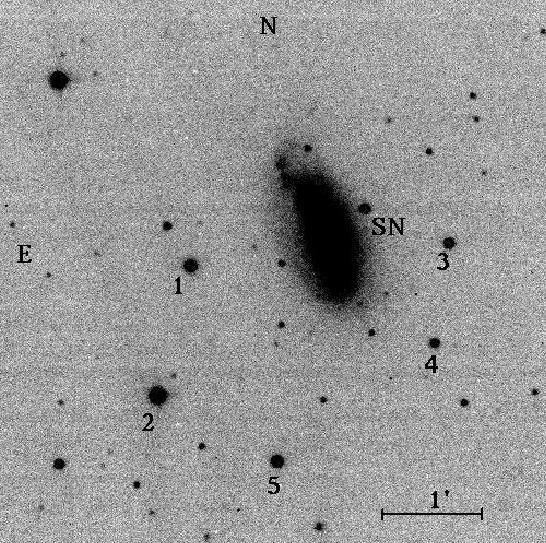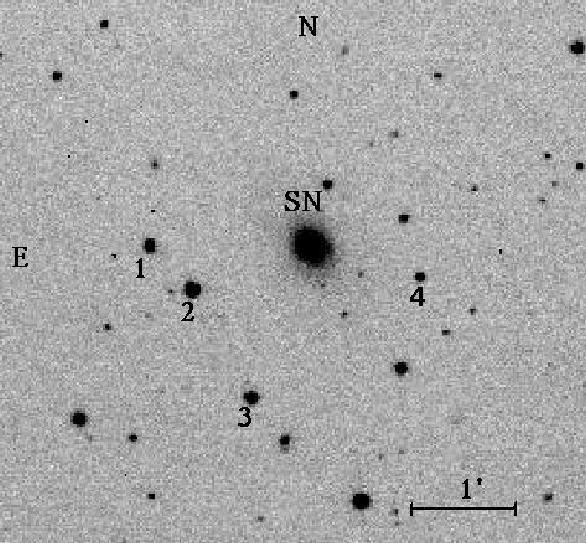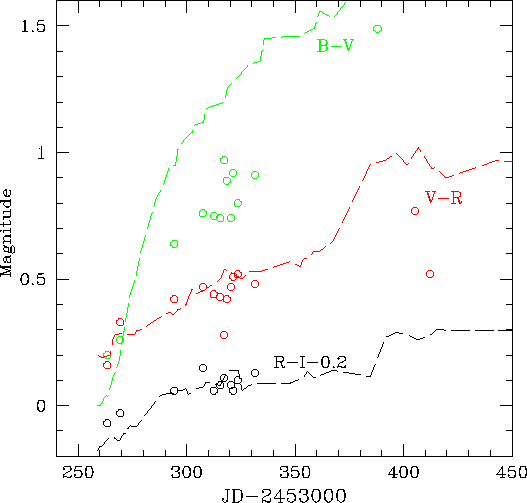|
Peremennye Zvezdy (Variable Stars) 28, No. 3, 2008 Received 22 February; accepted 29 February.
|
Article in PDF |
Photometric Observations of Two Type II-P Supernovae: Normal SN II-P 2004A and Unusual SN 2004ek
D. Yu. Tsvetkov
- Sternberg Astronomical Institute, University Ave.13, 119992 Moscow, Russia; e-mail: tsvetkov@sai.msu.su
|
CCD |
SN 2004A was discovered by Itagaki on January 9.84 UT at magnitude
15.7 (Nakano and Itagaki, 2004). It is located at
![]() (equinox
2000.0), which is approximately
(equinox
2000.0), which is approximately
![]() west and
west and
![]() north
from the poorly defined nucleus of the Sc galaxy NGC 6207.
Kawakita et al. (2004) reported that spectra obtained on January
11 showed blue continuum and prominent hydrogen Balmer lines with
P Cyg profiles, indicating a young SN II. The expansion velocity
was estimates as 12000 km s
north
from the poorly defined nucleus of the Sc galaxy NGC 6207.
Kawakita et al. (2004) reported that spectra obtained on January
11 showed blue continuum and prominent hydrogen Balmer lines with
P Cyg profiles, indicating a young SN II. The expansion velocity
was estimates as 12000 km s![]() . A detailed photometric and
spectroscopic study of SN 2004A was presented by Hendry et al.
(2006), they also reported probable identification of a progenitor
star in pre-explosion HST images.
. A detailed photometric and
spectroscopic study of SN 2004A was presented by Hendry et al.
(2006), they also reported probable identification of a progenitor
star in pre-explosion HST images.
SN 2004ek was discovered by Boles et al. (2004) on September 9.97
UT in the Sb galaxy UGC 724 at magnitude 17.1. The position of the
SN is
![]() (equinox 2000.0), which is
(equinox 2000.0), which is
![]() west and
west and
![]() north from the center of the galaxy. Modjaz et al. (2004) reported
that the spectrum obtained on September 14.47 was similar to the
early spectra of SN 1993J and showed featureless blue continuum
indicating a young SN II. Filippenko et al. (2004) confirmed these
conclusions with spectroscopic observations carried out on
September 24. The spectrum revealed blue continuum with weak
hydrogen Balmer and Fe II absorption lines, although the weak
H
north from the center of the galaxy. Modjaz et al. (2004) reported
that the spectrum obtained on September 14.47 was similar to the
early spectra of SN 1993J and showed featureless blue continuum
indicating a young SN II. Filippenko et al. (2004) confirmed these
conclusions with spectroscopic observations carried out on
September 24. The spectrum revealed blue continuum with weak
hydrogen Balmer and Fe II absorption lines, although the weak
H![]() line was almost entirely in emission.
line was almost entirely in emission.
We carried out observations of SN 2004A and 2004ek with the following telescopes and CCD cameras: the 60-cm reflector of the Crimean Observatory of Sternberg Astronomical Institute (C60) equipped with a Roper Scientific VersArray1300B CCD camera (a) or an Apogee AP-7p camera (b); the 50/70-cm meniscus telescope of the Crimean Observatory (C50) with a Meade Pictor 416XT camera; the 70-cm reflector in Moscow (M70) with Apogee AP-47p (a) or AP-7p (b) cameras. On January 30, images of SN 2004A were obtained with the 50-cm reflector at Tatranska Lomnica in Slovakia equipped with a SBIG ST-10 camera (S50).
The color terms for C60 and M70 were reported by Tsvetkov et al.
(2006). The observations at C50 were carried out only with a ![]() filter which was close to standard system, and no correction was
applied. The
filter which was close to standard system, and no correction was
applied. The ![]() passbands at S50 were quite close to standard
ones, and only minor corrections were needed.
passbands at S50 were quite close to standard
ones, and only minor corrections were needed.
The standard image reductions and photometry were made using IRAF1. Photometric measurements of SNe were made relative to local standard stars using PSF-fitting with IRAF DAOPHOT package. Both SNe occurred quite far from the centers of their parent galaxies. At the position of SN 2004ek, practically no host galaxy background was present, while for SN 2004A it was noticeable on the frames taken with longer exposures, when the SN was faint. Subtraction of host galaxy images was applied to some SN 2004A frames, but the results were found practically identical to those obtained without subtraction.
The magnitudes of local standards were calibrated on photometric nights, when photometric standards were observed at different airmasses. They are reported in Table 1, the images of the SNe with marked local standards are shown in Figs. 1,2. The results of our photometry of the supernovae are presented in Tables 2,3.
SN 2004A. We started monitoring this SN on 2004 January 30,
21 days after discovery, and continued observations until November
21. The magnitudes for our local standards were derived also by
Hendry et al. (2006), and the mean differences between the two
data sets are:
![]() . The differences of
. The differences of ![]() and
and ![]() magnitudes are quite significant. Hendry et al. (2006)
presented also another set of magnitudes, based on data from SDSS
DR4. We found that these magnitudes are in a much better agreement
with our calibration:
magnitudes are quite significant. Hendry et al. (2006)
presented also another set of magnitudes, based on data from SDSS
DR4. We found that these magnitudes are in a much better agreement
with our calibration:
![]() . However, Hendry et al.
(2006) preferred their own calibration for reduction of SN 2004A
photometry. We corrected the magnitudes from Hendry et al. (2006)
for the differences we found between the calibrations of local
standards and plotted them together with our data in Fig. 3. Also
shown are the results of CCD photometry (mostly unfiltered)
reported at the SNWeb site2. They show large systematic differences compared to our data, but
are tracing the early rising part of the light curve and so are
valuable for defining the explosion date.
. However, Hendry et al.
(2006) preferred their own calibration for reduction of SN 2004A
photometry. We corrected the magnitudes from Hendry et al. (2006)
for the differences we found between the calibrations of local
standards and plotted them together with our data in Fig. 3. Also
shown are the results of CCD photometry (mostly unfiltered)
reported at the SNWeb site2. They show large systematic differences compared to our data, but
are tracing the early rising part of the light curve and so are
valuable for defining the explosion date.
We fit the light curves of a typical SN II-P 1999em (Leonard et
al., 2002; Elmhamdi et al., 2003a; Hamuy et al., 2001) to the data
for SN 2004A and find a very good match, which is evident from
Fig. 3. The comparison confirms that the explosion occurred on
2004 January 6 (JD 2453011), as estimated by Hendry et al. (2006).
The plateau stage starts on JD 2453018. The end of the plateau can
be defined in different ways; if we assume that it is marked by
the point on the light curve corresponding to half of the
brightness drop from the plateau to the linear tail, which is at
about JD 242453124, then the plateau lasted for 106 days. The
maximum brightness was reached at about JD 2453075 in all bands
except ![]() :
:
![]() . The rate
of decline in
. The rate
of decline in ![]() at the plateau phase was 0.013 mag day
at the plateau phase was 0.013 mag day![]() .
The linear fits to the
.
The linear fits to the ![]() and
and ![]() magnitudes after JD 2453200
give the following decline rates:
magnitudes after JD 2453200
give the following decline rates:
![]() mag
day
mag
day![]() in the
in the ![]() band and
band and
![]() mag day
mag day![]() in the
in the ![]() band. These rates are very close to the decay slope of
band. These rates are very close to the decay slope of
![]() Co, which is 0.0098 mag day
Co, which is 0.0098 mag day![]() .
.
The color curves for SN 2004A are presented in Fig. 4 and are
compared to the color curves of SN 1999em. The agreement is quite
good, except some difference of ![]() curves at JD 2453080-120.
We have also obtained one estimate of
curves at JD 2453080-120.
We have also obtained one estimate of ![]() magnitude, which is not
included into Table 2: on JD 2453034.70,
magnitude, which is not
included into Table 2: on JD 2453034.70,
![]() ,
corresponding to the color
,
corresponding to the color
![]() . This value is
about 0.4 mag bluer than the color of SN 1999em at a comparable
epoch. Still we conclude that the color evolution of the two SNe
is similar and the extinction for them is also quite close. The
Galactic extinction in the direction of NGC 6207 is small:
. This value is
about 0.4 mag bluer than the color of SN 1999em at a comparable
epoch. Still we conclude that the color evolution of the two SNe
is similar and the extinction for them is also quite close. The
Galactic extinction in the direction of NGC 6207 is small:
![]() according to Schlegel et al. (1998). For SN 1999em, the
total extinction of
according to Schlegel et al. (1998). For SN 1999em, the
total extinction of
![]() is accepted in most studies
(Elmhamdi et al., 2003a). We conclude that for SN 2004A the total
extinction is close to this value.
is accepted in most studies
(Elmhamdi et al., 2003a). We conclude that for SN 2004A the total
extinction is close to this value.
The distance to NGC 6207 is rather controversial: the radial
velocity corrected for the Virgo infall is 1240 km s![]() according to NASA/IPAC Extragalactic Database3 (NED), corresponding to
distance of 17 Mpc with
according to NASA/IPAC Extragalactic Database3 (NED), corresponding to
distance of 17 Mpc with ![]() =73 km s
=73 km s![]() Mpc
Mpc![]() . However,
Hendry et al. (2006) estimate the distance using HST photometry of
the brightest supergiants and find out that this method gives
distances in the range from 17.7 to 26.8 Mpc. Finally they accept
the mean of different estimates, including those from kinematics,
which is
. However,
Hendry et al. (2006) estimate the distance using HST photometry of
the brightest supergiants and find out that this method gives
distances in the range from 17.7 to 26.8 Mpc. Finally they accept
the mean of different estimates, including those from kinematics,
which is ![]() Mpc. Recently the distance to NGC 6207 was
also estimated by
Mpc. Recently the distance to NGC 6207 was
also estimated by ![]() -band Tully-Fisher relation (Springob et al.,
2007) and found to correspond to radial velocity 1346 km s
-band Tully-Fisher relation (Springob et al.,
2007) and found to correspond to radial velocity 1346 km s![]() .
This means the distance of 18.4 Mpc, and we accept this value as
more probable. Using this distance and extinction
.
This means the distance of 18.4 Mpc, and we accept this value as
more probable. Using this distance and extinction ![]() , we
construct the absolute
, we
construct the absolute ![]() light curve, which is illustrated in
Fig. 7. The light curve of SN 1999em is plotted for comparison
(with Cepheid distance 11.7 Mpc and
light curve, which is illustrated in
Fig. 7. The light curve of SN 1999em is plotted for comparison
(with Cepheid distance 11.7 Mpc and ![]() ). Both SNe appear
quite similar, although SN 1999em is about 0.5 mag brighter at the
plateau stage. With absolute magnitude at plateau of
). Both SNe appear
quite similar, although SN 1999em is about 0.5 mag brighter at the
plateau stage. With absolute magnitude at plateau of ![]() ,
SN 2004A certainly belongs to SNe II-P with normal luminosity.
,
SN 2004A certainly belongs to SNe II-P with normal luminosity.
We can try to estimate also the amount of ![]() Ni ejected in the
explosion by three methods: comparison to the tail luminosity of
SN 1987A; correlations between
Ni ejected in the
explosion by three methods: comparison to the tail luminosity of
SN 1987A; correlations between ![]() Ni mass and plateau
Ni mass and plateau ![]() and the steepness parameter
and the steepness parameter ![]() , which is the maximum gradient
during the transition from the plateau to the tail, in mag
day
, which is the maximum gradient
during the transition from the plateau to the tail, in mag
day![]() (Elmhamdi et al., 2003b). According to our data, the
luminosity at radioactive tail for SN 2004A is about 0.8 mag below
than for SN 1987A, and assuming that the same relation holds for
bolometric luminosity, we derive
(Elmhamdi et al., 2003b). According to our data, the
luminosity at radioactive tail for SN 2004A is about 0.8 mag below
than for SN 1987A, and assuming that the same relation holds for
bolometric luminosity, we derive ![]() Ni mass in SN 2004A to be
about 2.07 times less than in SN 1987A, that is 0.036
Ni mass in SN 2004A to be
about 2.07 times less than in SN 1987A, that is 0.036 ![]() .
We estimate the parameter
.
We estimate the parameter ![]() for SN 2004A to be approximately
0.12 mag day
for SN 2004A to be approximately
0.12 mag day![]() , although the coverage of the light curve is
not quite good at that stage, this value corresponds to
, although the coverage of the light curve is
not quite good at that stage, this value corresponds to
![]() . And finally, the correlation
between plateau luminosity and
. And finally, the correlation
between plateau luminosity and ![]() Ni mass yields
Ni mass yields
![]() . We conclude that all estimates agree
reasonably well and confirm that SN 2004A is a normal SN II-P.
. We conclude that all estimates agree
reasonably well and confirm that SN 2004A is a normal SN II-P.
SN 2004ek. We observed this SN from 2004 September 14 (5
days after discovery) until 2005 Ferbuary 10. The light curves are
presented in Fig. 5, where we also plotted unfiltered CCD
magnitudes reported at SNWeb4. These data show the early rise of brightness and allow to conclude
that the explosion likely occurred on about September 8 (JD
2453256). SN 2004ek certainly belongs to the SN II-P class, but
the differences between the light curves of SN 2004ek and those
for typical SNe II-P is evident. In the ![]() band, SN 2004ek has a
long period (JD 2453290-340) of constant brightness, while all
normal SNe II-P have nearly linear decline at that stage. In the
band, SN 2004ek has a
long period (JD 2453290-340) of constant brightness, while all
normal SNe II-P have nearly linear decline at that stage. In the
![]() band, there are two peaks on the light curve, one immediately
after the outburst and the second one at about JD 2453330. In the
band, there are two peaks on the light curve, one immediately
after the outburst and the second one at about JD 2453330. In the
![]() and
and ![]() bands, after the period of constant brightness, there
is a prominent increase of luminosity, amounting to 0.3 mag in
bands, after the period of constant brightness, there
is a prominent increase of luminosity, amounting to 0.3 mag in ![]() and 0.4 mag in
and 0.4 mag in ![]() . The early decline after the plateau is
probably quite slow, the gradient in
. The early decline after the plateau is
probably quite slow, the gradient in ![]() is only
0.013 mag day
is only
0.013 mag day![]() . These features are unique among well-studied
SNe II-P.
. These features are unique among well-studied
SNe II-P.
The color curves are illustrated in Fig. 6 and are compared to the curves
for SN 1999em. The ![]() curves of SN 2004A and 1999em are
different, although the values of
curves of SN 2004A and 1999em are
different, although the values of ![]() at early stage are similar.
The shape of
at early stage are similar.
The shape of ![]() and
and ![]() curves is similar for both objects.
curves is similar for both objects.
As SN 2004ek exploded far from the center of its parent galaxy,
at the distance close to the photometric radius, the extinction inside
the galaxy should be small. The Galactic extinction in the direction
of UGC 724 is ![]() according to Schlegel et al. (1998). Accepting
this value as total extinction and the distance 73 Mpc from NED, we
obtain maximum absolute magnitude
according to Schlegel et al. (1998). Accepting
this value as total extinction and the distance 73 Mpc from NED, we
obtain maximum absolute magnitude ![]() , a high luminosity for
SN II-P. The absolute
, a high luminosity for
SN II-P. The absolute ![]() -light curve for SN 2004ek is shown in
Fig. 7. SN 2004ek is similar in luminosity to one of the brightest known
SN II-P 1992am (Schmidt et al., 1994), but the shape of the light curve
is different. The light curves of SNe 1999em and 2004ek can also be
compared on Fig. 7, and it is evident that the plateau lasted longer
for SN 2004ek and that the shape of the light curve on the plateau
is different.
-light curve for SN 2004ek is shown in
Fig. 7. SN 2004ek is similar in luminosity to one of the brightest known
SN II-P 1992am (Schmidt et al., 1994), but the shape of the light curve
is different. The light curves of SNe 1999em and 2004ek can also be
compared on Fig. 7, and it is evident that the plateau lasted longer
for SN 2004ek and that the shape of the light curve on the plateau
is different.
The reports on spectroscopic observations of SN 2004ek (Modjaz et al., 2004;
Filippenko et al., 2004) confirm the peculiar nature of this object.
Spectrum obtained on September 14.47 (about 6 days past explosion) showed
featureless blue continuum, and even on September 24 (16 days past
outburst) the absorption lines were weak, and H![]() line was
almost entirely in emission. The spectra of typical SNe II-P already show
prominent hydrogen Balmer lines with P-Cyg profiles at phase about
2-3 days, and at phase
line was
almost entirely in emission. The spectra of typical SNe II-P already show
prominent hydrogen Balmer lines with P-Cyg profiles at phase about
2-3 days, and at phase ![]() 16 days the absorption lines become much
deeper.
16 days the absorption lines become much
deeper.
SN 2004ek has peculiar shape of the light curves in
![]() bands and shape of
bands and shape of ![]() color curve, long duration of the
plateau and high luminosity, unusual spectral evolution. Among
well-studied SNe II-P there is no analog to SN 2004ek. Unfortunately,
our observations of this object are not detailed, and we have no
data on the tail of the light curve. We appeal to all observers
who collected data on this SN to turn their attention to this
interesting object, which may be important for revealing
the diversity of type II SNe.
color curve, long duration of the
plateau and high luminosity, unusual spectral evolution. Among
well-studied SNe II-P there is no analog to SN 2004ek. Unfortunately,
our observations of this object are not detailed, and we have no
data on the tail of the light curve. We appeal to all observers
who collected data on this SN to turn their attention to this
interesting object, which may be important for revealing
the diversity of type II SNe.
Acknowledgments: This research has made use of the NASA/IPAC Extragalactic Database (NED) which is operated by the Jet Propulsion Laboratory, California Institute of Technology, under contract with NASA. The author is grateful to S.Yu.Shugarov, I.M.Volkov and N.N.Pavlyuk, who made some observations, and to I.Myakishev and Meredith Rawls, who took part in reductions of observations. The work was partly supported by the grant 05-02-17480 from RFBR.
References:
Boles, T., Puckett, T., Cox, L., 2004, IAU Circ., No. 8405
Filippenko, A.V., Ganeshalingam, M., Swift, B.J., 2004, IAU Circ., No. 8411
Hamuy, M., Pinto, P.A., Maza, J., et al., 2001, Astrophys. J., 558, 615
Hendry, M.A., Smartt, S.J., Crockett, R.M., et al., 2006, MNRAS, 369, 130
Elmhamdi, A., Danziger, I.J., Chugai, N., et al., 2003a, MNRAS, 338, 939
Elmhamdi, A., Chugai, N.N., Danziger, I.J., 2003b, Astron. Astrophys., 404, 1077
Kawakita, H., Kunigasa, K., Ayani, K., Yamaoka, H., 2004, IAU Circ., No. 8266
Leonard, D.C., Filippenko, A.V., Gates, E.L., et al., 2002, PASP, 114, 35
Modjaz, M., Kirshner, R., Challis, P., Matheson, T., 2004, IAU Circ., No. 8409
Nakano, S., Itagaki, K., 2004, IAU Circ., No. 8265
Schlegel, D., Finkbeiner, D., Davis, M., 1998, Astrophys. J., 500, 525
Schmidt, B. P., Kirshner, R. P., Eastman, R. G., et al., 1994, Astron. J., 107, 1444
Springob, C.M., Masters, K.L., Haynes, M.P., Giovanelli, R., Marinoni, C., 2007, Astrophys. J. Suppl. Ser., 172, 599
Tsvetkov, D.Yu., Volnova, A.A., Shulga, A.P., Korotkiy, S.A., Elmhamdi, A., Danziger, I.J., Ereshko, M.V., 2006, Astron. Astrophys., 460, 769
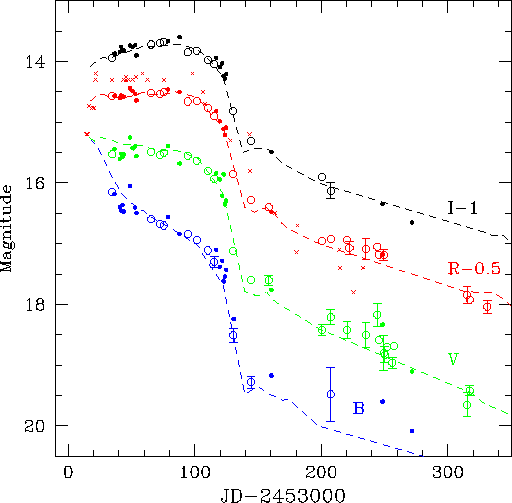 |
Fig. 3.
|
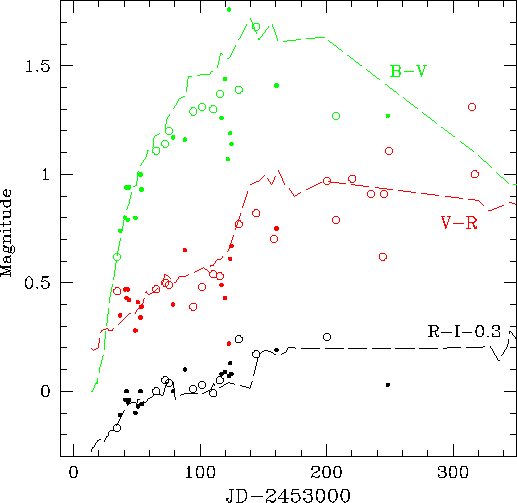 |
Fig. 4. The color curves of SN 2004A, showing our photometry (circles) and that of Hendry et al. (2001) (dots). The dashed lines are the color curves of SN 1999em |
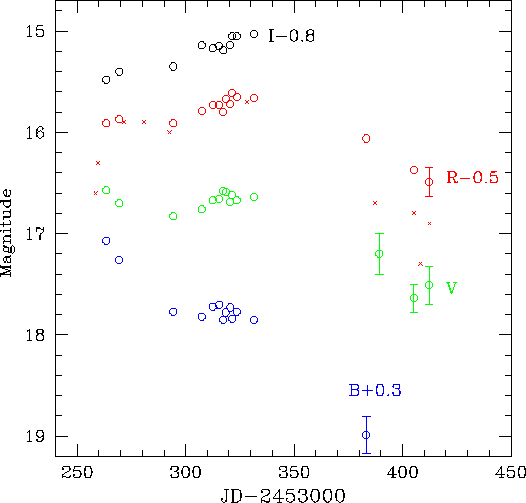 |
Fig. 5.
|
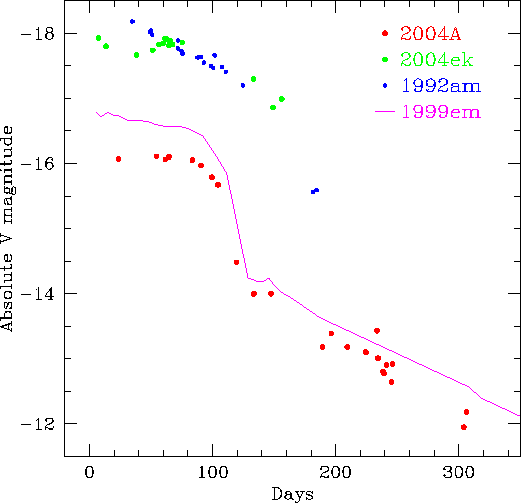 |
Fig. 7.
The absolute |
| Star | ||||||||||
| 2004A-1 | 14.70 | 0.07 | 14.66 | 0.04 | 14.05 | 0.01 | 13.65 | 0.03 | 13.38 | 0.03 |
| 2004A-2 | 14.55 | 0.06 | 14.00 | 0.03 | 13.11 | 0.02 | 12.55 | 0.03 | 12.15 | 0.04 |
| 2004A-3 | 16.12 | 0.03 | 15.22 | 0.01 | 14.78 | 0.02 | 14.40 | 0.04 | ||
| 2004A-4 | 16.39 | 0.03 | 15.66 | 0.02 | 15.27 | 0.03 | 14.94 | 0.05 | ||
| 2004A-5 | 15.05 | 0.04 | 14.34 | 0.02 | 13.96 | 0.03 | 13.61 | 0.05 | ||
| 2004ek-1 | 15.59 | 0.01 | 14.96 | 0.01 | 14.58 | 0.01 | 14.28 | 0.01 | ||
| 2004ek-2 | 14.97 | 0.01 | 14.01 | 0.01 | 13.46 | 0.01 | 12.97 | 0.02 | ||
| 2004ek-3 | 15.31 | 0.01 | 14.66 | 0.01 | 14.29 | 0.02 | 13.96 | 0.02 | ||
| 2004ek-4 | 17.05 | 0.04 | 16.50 | 0.02 | 16.21 | 0.03 | 15.90 | 0.05 |
| JD 2453000+ | Tel. | ||||||||
| 34.70 | 16.15 | 0.03 | 15.53 | 0.04 | 15.07 | 0.02 | 14.94 | 0.03 | S50 |
| 65.53 | 16.60 | 0.02 | 15.49 | 0.02 | 15.02 | 0.02 | 14.72 | 0.02 | C60b |
| 72.62 | 16.68 | 0.04 | 15.54 | 0.02 | 15.04 | 0.02 | 14.69 | 0.03 | C60b |
| 75.56 | 16.70 | 0.03 | 15.50 | 0.02 | 15.01 | 0.02 | 14.67 | 0.03 | M70a |
| 94.54 | 16.84 | 0.07 | 15.55 | 0.03 | 15.16 | 0.05 | 14.85 | 0.06 | M70a |
| 101.48 | 16.94 | 0.03 | 15.63 | 0.02 | 15.15 | 0.01 | 14.82 | 0.02 | M70a |
| 110.51 | 17.11 | 0.03 | 15.81 | 0.02 | 15.27 | 0.03 | 14.98 | 0.02 | M70a |
| 115.52 | 17.30 | 0.09 | 15.93 | 0.03 | 15.40 | 0.03 | 15.05 | 0.04 | M70a |
| 130.49 | 18.51 | 0.12 | 17.12 | 0.07 | 16.35 | 0.03 | 15.81 | 0.06 | M70a |
| 144.44 | 19.28 | 0.10 | 17.60 | 0.06 | 16.78 | 0.02 | 16.31 | 0.04 | M70a |
| 158.43 | 17.60 | 0.08 | 16.90 | 0.03 | M70a | ||||
| 200.40 | 18.42 | 0.09 | 17.45 | 0.05 | 16.90 | 0.07 | M70b | ||
| 207.40 | 19.48 | 0.45 | 18.21 | 0.12 | 17.42 | 0.04 | 17.13 | 0.13 | M70b |
| 220.39 | 18.42 | 0.14 | 17.44 | 0.06 | M70b | ||||
| 222.38 | 17.57 | 0.10 | M70b | ||||||
| 235.38 | 18.50 | 0.21 | 17.59 | 0.17 | M70b | ||||
| 244.38 | 18.17 | 0.19 | 17.55 | 0.06 | M70b | ||||
| 245.37 | 18.59 | 0.06 | 17.68 | 0.03 | C60a | ||||
| 249.33 | 18.80 | 0.29 | 17.69 | 0.09 | M70b | ||||
| 250.26 | 18.83 | 0.13 | C50 | ||||||
| 252.25 | 18.70 | 0.07 | C50 | ||||||
| 256.26 | 18.96 | 0.09 | C50 | ||||||
| 257.23 | 18.68 | 0.07 | C50 | ||||||
| 315.21 | 19.65 | 0.20 | 18.34 | 0.14 | C60a | ||||
| 317.22 | 19.42 | 0.08 | 18.42 | 0.05 | C60a | ||||
| 331.24 | 18.54 | 0.10 | C60a |
| JD 2453000+ | Tel. | ||||||||
| 263.47 | 16.77 | 0.03 | 16.57 | 0.03 | 16.41 | 0.02 | 16.28 | 0.04 | M70b |
| 269.41 | 16.96 | 0.03 | 16.70 | 0.04 | 16.37 | 0.04 | 16.20 | 0.05 | M70b |
| 294.26 | 17.47 | 0.03 | 16.83 | 0.03 | 16.41 | 0.03 | 16.15 | 0.03 | M70a |
| 307.41 | 17.52 | 0.06 | 16.76 | 0.04 | 16.29 | 0.03 | 15.94 | 0.03 | M70a |
| 312.51 | 17.42 | 0.04 | 16.67 | 0.03 | 16.23 | 0.03 | 15.97 | 0.03 | M70a |
| 315.45 | 17.40 | 0.04 | 16.66 | 0.02 | 16.23 | 0.02 | 15.95 | 0.05 | C60a |
| 317.30 | 17.55 | 0.03 | 16.58 | 0.02 | 16.30 | 0.02 | 15.99 | 0.05 | C60a |
| 318.50 | 17.48 | 0.04 | 16.59 | 0.03 | 16.17 | 0.04 | C60a | ||
| 320.45 | 17.43 | 0.02 | 16.69 | 0.02 | 16.22 | 0.02 | 15.94 | 0.04 | C60a |
| 321.47 | 17.54 | 0.03 | 16.62 | 0.02 | 16.11 | 0.01 | 15.85 | 0.04 | C60a |
| 323.49 | 17.47 | 0.03 | 16.67 | 0.02 | 16.15 | 0.02 | 15.85 | 0.03 | C60a |
| 331.47 | 17.55 | 0.04 | 16.64 | 0.02 | 16.16 | 0.02 | 15.83 | 0.03 | C60a |
| 383.27 | 18.69 | 0.18 | 16.56 | 0.04 | M70a | ||||
| 389.37 | 17.20 | 0.20 | M70a | ||||||
| 405.22 | 17.64 | 0.14 | 16.87 | 0.07 | M70a | ||||
| 412.26 | 17.51 | 0.19 | 16.99 | 0.14 | M70a |
Footnotes
- ... IRAF.1 IRAF is distributed by the National Optical Astronomy Observatory, which is operated by AURA under cooperative agreement with the National Science Foundation
- ... site.2 http://www.astrosurf.com/snweb2/2004/04A_/04A_Meas.htm
- ... Database3 http://nedwww.ipac.caltech.edu
- ... SNWeb.4 http://www.astrosurf.com/snweb2/2004/04/04ek_Meas.htm
